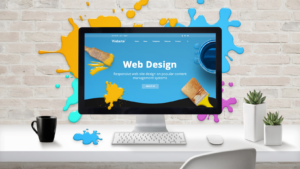In the vast universe of design, two stars shine brightly – web design vs graphic design. They’re often mistaken as interchangeable terms, yet they represent distinct disciplines. This article aims to dissect these two fields, highlighting their similarities and differences.
Join us as we delve into the world of pixels and vectors, exploring the exciting realms of web design and graphic design. Whether you’re a seasoned professional or a curious novice, there’s a wealth of insights to be discovered.
Web Design vs Graphic Design

Delving deeper into the sieve of digital aesthetics, exploration uncovers two adjacent yet distinct realms: web design vs graphic design. These discourses blend artistry with functionality, imprinting unique experiences on our digital interactions.
Web design shapes the visual appeal and usability of websites. It encompasses diverse skills, like user interface (UI) design, user experience (UX) design, and search engine optimization (SEO). UI focuses on aesthetic appeal, ensuring a visually engaging usage experience. Moreover, UX employs strategic planning to facilitate navigation through the site, aiming to enhance user satisfaction and retention rates. By optimizing SEO, web designers ensure improved visibility of the websites on search engines. Notably, Facebook’s crisp layout, intuitive navigation, and fast-loading elements exemplify effective web design.
Contrastingly, graphic design relates to visual communication through images, typography, and illustrations. Graphic designers create engaging visuals to convey messages, promote brands, and appeal emotionally to the audience. Their creations spread across diverse media including logos, brochures, advertisements, and book covers. Ultimately, graphic design heightens brand recognition while enhancing aesthetic appeal. An iconic example is Apple’s logo, which cleverly incorporates minimalist design, expressing simplicity and sophistication, hallmarks of the brand’s products.
Key Differences Between Web Design and Graphic Design

Delving deeper into web design vs graphic design reveals key differences. Primarily, these two disciplines vary in terms of skills required, objectives, user interaction, and the tools they utilize.
Web design demands proficiency in coding languages like HTML, CSS, and JavaScript. It’s essential for designers in this field to master different web standards and design platforms, including the likes of WordPress or Joomla. Additionally, web designers often integrate SEO practices into their design to augment website discoverability.
On the other hand, graphic designers leverage their creativity and aesthetic acumen to produce compelling visual content.
Primary Objectives and User Interaction
While both disciplines aim to create visually appealing interfaces, their primary objectives and forms of user interaction diverge. Web design is interactive—it’s about creating platforms that users can navigate with ease. To achieve this, web designers concentrate on user interface (UI) design, user experience (UX), and navigability.
Conversely, graphic design is inherently static. The focus is on conveying a message or concept through visual means. It’s less about user navigation and more about influencing the viewer’s perception, emotions, and responses to an image or layout.
Career Opportunities in Web Design and Graphic Design

Building on the distinct tools, techniques, and objectives within web design and graphic design presents myriad career opportunities in both fields. Let’s delve into specific pathways linked to these two disciplines making waves in the digital age.
Web design boasts a spectrum of career options. Start with a Front-End Developer, he’s tasked to implement and manage visual elements users interact with. The Web Developer, on the other hand, ensures website’s seamless functionality through back-end processes. The UI/UX Designer creates intuitive navigation for enhanced user experiences. SEO Specialist enhances website visibility on search engines, given the website’s success hinges on SEO integration. Lastly, WordPress Developer specializes in designing and managing websites on the WordPress platform. Here’s a simple table highlighting these roles:
| Career Path | Responsibilities |
|---|---|
| Front-End Developer | Implementing user interface components |
| Web Developer | Ensuring seamless website functionality |
| UI/UX Designer | Creating intuitive, interactive web navigation |
| SEO Specialist | Optimizing website visibility on search engines |
| WordPress Developer | Designing, managing websites on WordPress platform |
| Career Path | Responsibilities |
|---|---|
| Graphic Designer | Creating effective visual messages |
| Logo Designer | Crafting unique brand logos |
| Brand Identity Designer | Designing visual components of company’s identity |
| Illustrator | Crafting artwork and illustrations |
| Multimedia Designer | Designing visual content for film, video production |

